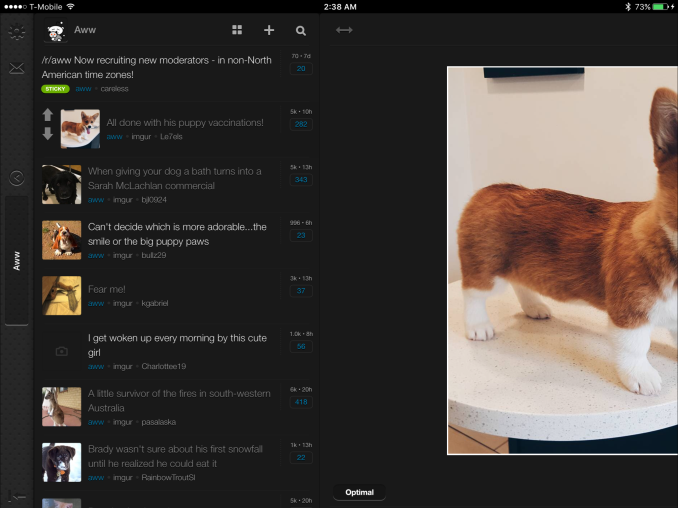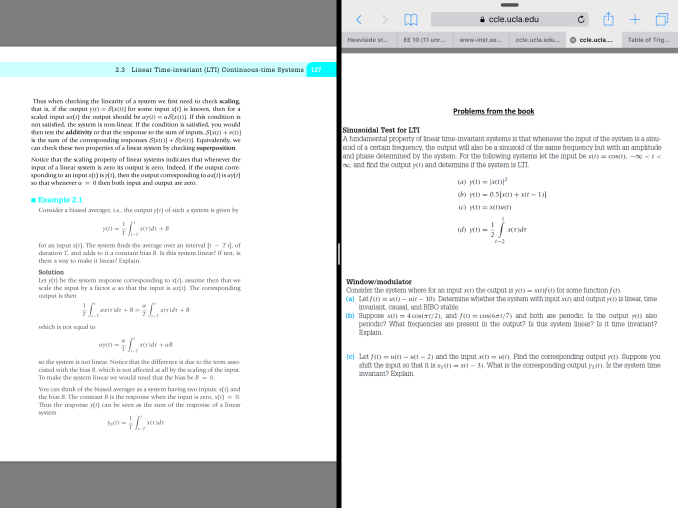The Apple iPad Pro Review
by Ryan Smith, Joshua Ho & Brandon Chester on January 22, 2016 8:10 AM ESTSoftware UX
For those that are unfamiliar with our other articles, we reviewed iOS 9 at its release back in September. If you aren’t familiar with what has changed in the move from iOS 8 to iOS 9 I highly recommend reading it as for the most part I have nothing new to say in the context of what was covered in that review. Instead of treading old ground, it’s worth discussing the specific aspects of the user experience that are unique to the iPad Pro.
The first, and perhaps most obvious change is the display size and resolution. While the aspect ratio is the same as the iPad Air, the significantly increased display size and resolution also affects applications. For the most part I haven’t noticed any issues here. However, in some cases there are still applications that haven’t been properly redesigned for the larger display, so they end up simply being purely upscaled versions of applications designed to fit 7.9 and 9.7 inch displays. This tends to look fairly ugly in my opinion but it does work without issue when dealing with backwards compatibility.
In cases where applications are updated to fit the iPad Pro, designs are generally well-executed and take advantage of the additional screen real estate. It’s probably not a surprise to know that most applications fall under this category, but it’s worth mentioning at any rate.
The larger display size also greatly enhances the utility of split-screen multitasking on the iPad Pro, as it’s generally quite useful to be able to run two almost iPad Air-sized apps simultaneously on the iPad Pro. As discussed in the Apple Pencil section of this review, being able to read a PDF and take notes/do problem sets based upon a document opened in Safari is incredibly useful and helps with productivity. There are other applications here to be sure, but I think an education setting was where I found the most value. However, it's worth mentioning that the multitasking UI feels like it isn't really designed for a future where hundreds of applications will occupy the slide-out multitasking menu.
For the most part, iOS is smooth and performant on the iPad Pro. However, there are a few notable cases where I did notice frame drops. For whatever reason, this seems to be basically limited to the Notes application. It seems that as time has gone on it has become increasingly difficult for anyone shipping a mobile OS to make everything smooth all the time, likely a product of their increasing complexity and larger code base.
Overall, I don't have as much to say here. When the only two competing tablet operating systems worth discussing in comparison to iOS are either neglected (Android) or heavily reliant upon legacy applications that really need a mouse and keyboard to be used properly (Windows), iOS stands alone as basically the only touchscreen OS worth using. I don't think the solution to the problem of the keyboard with the iPad Pro means that it needs a touchpad, nor should using both keyboard and touch simultaneously in the deployed mode be the dominant method of interaction. Trying to do the former is basically just emulating a really terrible laptop, while the latter makes for poor ergonomics almost universally.
While it may be appealing to make a tablet that is also a laptop due to the nature of legacy Windows applications, trying to make such a convergence device is a great way to make either a compromised laptop or a compromised tablet. The other half of the functionality is almost never going to be used in practice if my experiences with Surface Pro are anything to go by. Android showed arguably even more promise than iOS as a tablet OS due to its more traditional computer than appliance OS structure, for whatever reason the promise that came with the structure of Android didn't pan out in execution.
As a result, the iPad line stands alone in software, for better or for worse.













408 Comments
View All Comments
HammerStrike - Friday, January 22, 2016 - link
"I beg your pardon, Miss Taggart," he had said, offended. "I don't know what you mean when you say that I haven't made use of the metal. This design is an adaptation of the best bridges on record.What else did you expect?”
"A new method of construction."
"What do you mean, a new method?"
"I mean that when men got structural steel, they did not use it to build steel copies of wooden bridges."
Ann Rand, "Atlas Shrugged"
The question around the iPad Pro is not is it a close enough copy of a workstation to do workstation work, but does it enable new work streams that were previously unexplored. As has been previously noted, the Surface Pro 4 is an extremely capable piece of hardware that checks all the same boxes as the iPad Pro, but no software had been designed to take advantage of it's unique form factor - it's still using a wooden design on a steel bridge.
The real differentiation for the iPad Pro is iOS, and the touch first / mobility first design mentality it brings to the table - software has to be written specifically for that environment and usage case. There are some notable hardware and input difference between the iPad Pro and previous iOS devices - time will tell if they can be combined to provide real productivity improvements vs previous designs or if they are merely novelties that will be quickly forgotten. Jury is still out on that, but if anyone can build the "critical mass" to jump start that exploration it's Apple. Hopefully some apps come out and wow us - to channel Asimov, there is a single light usage case advancement, and to progress it anywhere is to progress it everywhere.
name99 - Friday, January 22, 2016 - link
I simply cannot figure your complaint: "It is a computer, REDUCED to an accessory, which COULD be THAT MUCH MORE USEFUL."So what do you want? You want the iPad Pro form factor running OSX? You want the ability to plug in a second screen? You want to be able to install Windows?
Your complaint seems to be "this is not a Surface Pro 4". It isn't MEANT to be.
It's meant to be a larger screen version of an iPad, for those for whom an iPad is an appropriate device. If you're not one of those people, WTF does it matter to you? Do you hang around bicycle tracks telling everyone there they should be using a motorbike or a car or a truck because those are more powerful?
You are stuck in a certain vision of what a computer is "supposed" to be, every bit as much as IBM confronted by DEC couldn't imagine a computer that wasn't a mainframe, then DEC confronted by Apple, Atari, etc couldn't imagine a computer that wasn't a mini, then in 2007 people couldn't imagine a pocket computer.
If you want to think of this as an "accessory" to a Mac, go ahead. I don't see what the value of that analogy, or why it's supposed to be an insult (Apple grew to the company it is today on the back of that accessory, the iPod...). People loved their iPods, they love their iPhones (especially the way they work together seamlessly with their Macs), and I expect they will love their iPad Pros.
Jumangi - Saturday, January 23, 2016 - link
Actually it is being touted as surface competition. Apple PR pushes this as a laptop replacement and its pricing is right with the Surface. Totally valid to compare the two.Constructor - Saturday, January 23, 2016 - link
You can do that. And Apple does indeed propose it as such – among very many other things, quite a few of which are actually better served by an iPad than by a conventional notebook.Just one example among many: The ability to simply use it in portrait mode already makes a huge difference for anything document-related, for which the narrow widescreens on computers are woefully inadequate.
MaxIT - Saturday, February 13, 2016 - link
Indeed it is. And it's way better than a Surface Pro, because it runs an OS that is actually designed to be used with a touch interface, while the Surface doesn't....Relic74 - Saturday, February 27, 2016 - link
Windows 10 was designed to be used with touch as well, it's silly to even think otherwise. People who such things have never used one before, simple as that.The Hardcard - Friday, January 22, 2016 - link
It's not about now. Yes now I have a laptop for things my device can't do, and a desktop for things my laptop can't do timely.But I am excited that soon devices that can be carried and pocketed will soon be powerful enough and have the software to do every thing I want to do in a timely fashion.
The iPad Pro marks the beginning of the final stage of the mobile transition, being THE computer for all mainstream activities.
There will still be larger form factors, just as there will still be mainframes. But most homes and many business won't have them.
In fact, that is what IBMs new angle is. The occasional or particular high-power computation you need done elsewhere, results served to your device. Most people won't even need that
RafaelHerschel - Saturday, January 23, 2016 - link
Conditioning I guess. Some people can't imagine that using the right tool for the job is more important than using a form factor that was originally designed for media consumption.Ananke - Friday, January 22, 2016 - link
Pros use Oracle, SAP, Cytrix for 98% of hardware, and some other exotic stuff amounts for the 2% left...Hence, nobody will approve capital expense of $1000+ on software unsupported device, when a $329 workstation can just do it. Software companies don't bother to bring the huge databases to exotic silicon either, when there are already CHEAPER well developed alternatives.Tablets are great for POS terminals, some apps that require mobile high quality visual content, and that's it pretty much. There is just no functionality need for something else, especially an expensive one.
mrcaffeinex - Friday, January 22, 2016 - link
In the office where I work, the iPad Pro may be the device people have been looking for. All of our remote application access goes through Citrix, with the most-used applications being Outlook for e-mail, Word for document review/minor editing, and Adobe Reader for PDF viewing. The experience on the iPad currently is not great, because the desktop versions of these applications do not translate well to the touch-first environment. The stylus and keyboard cover, coupled with the enhanced resolution, could make a difference.It is not a solution for everyone, but I have been fielding calls from our users already about wanting these, so there is potentially some kind of market to cater to here. I realize that from a technology standpoint there are more powerful alternatives and that there are other ways to approach the software situation, but at the end of the day, this is the kind of device that our users want: an iPad with a slightly bigger screen, responsive stylus input, and a keyboard cover in a convenient package, not to mention the implied prestige of Apple product ownership (in some circles the image is considered very important).
Time will tell if this is a fad or a long-term product line strategy. If Apple can turn a profit with these (and they do have a history of turning a profit on their devices), even in spite of a limited market appeal, they will probably keep marketing them.